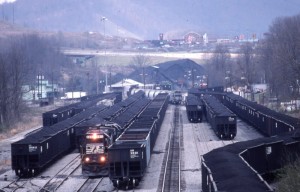by Harry J. Dolan (Retired NS Trainmaster)
 Working the N&W’s Norton yard in Southwestern Virginia required sets of six-axle locomotives. The yard has a 1% descending grade from west to east. Tracks 1 thru 8 (original numbering) hold 40 hoppers each; at 100 tons each, that is 4000 tons. One six-axle unit at Norton couldn’t handle much more than switching the caboose track. One Dash-8 would not even pull the 21 loads out of Norton Coal (switch off N&W Main at the east end of yard that crossed the Miller Yard Main of Interstate in Norton).
Working the N&W’s Norton yard in Southwestern Virginia required sets of six-axle locomotives. The yard has a 1% descending grade from west to east. Tracks 1 thru 8 (original numbering) hold 40 hoppers each; at 100 tons each, that is 4000 tons. One six-axle unit at Norton couldn’t handle much more than switching the caboose track. One Dash-8 would not even pull the 21 loads out of Norton Coal (switch off N&W Main at the east end of yard that crossed the Miller Yard Main of Interstate in Norton).
Just to give you an example as to what tonnage and a 1% grade will do let’s assemble an eastbound train with three SD-40s, 90 loads (at Norton, unless otherwise noted a “load” is assumed to be coal), and a caboose in Norton yard with the units just clear of the eastbound signal at the East end of the yard. Federal Law requires an “Initial Terminal” air brake test prior to departure. For an “Initial Terminal” air test, the crew would charge the brake pipe, apply the brakes, check leakage, inspect each car to determine if the brake is applied, then release the brake and inspect each car to determine that the brake on each car releases.
It sounds simple, however, when your release the brakes on the train, the only brakes remaining to keep the train from rolling away are the independent brakes on the locomotives, i.e., brakes on 18 axles of the units. At Norton, that is not enough brake to hold the train in the yard. Hence, if your release the brakes on the train and try to hold it with the locomotive brakes, the weight of the train will shove the locomotives with the wheels sliding out of Norton. Hence, in order to make a brake test, 8 to 10 hand brakes must be applied to the train while the brake test is conducted. Then, when the train is ready to leave, a first service (7 pound) reduction is made, the hand brakes are released, the independent brake on the locomotives released, and the train can leave Norton.
Tunnels on the Clinch Valley
The five tunnels between Norton and St. Paul, Virginia had very tight clearances. If the track was just 1″ out of alignment, the radiator cowls on the locomotives would scrape the sides of the tunnel. That is a real experience, coming down grade with 13,000 tons of coal shoving on your rear end, and the fire (sparks) starts flying off the tunnel walls because your locomotive is scraping the side of the tunnel. About the only cars which would clear those tunnels were hoppers and a standard 40′ box car. Cars which exceeded car outline “Plate C”, like many covered hoppers, bulk head flats, large tank cars, 60′ box cars, etc., would not clear.
When it comes to hills and curves, the Norton Territory had only 1 mile of level track and only 1 mile of tangent (straight) track, all the rest was either up grade, down grade, or curved.
Related Products:





Enjoyed reading that info. Thanks.